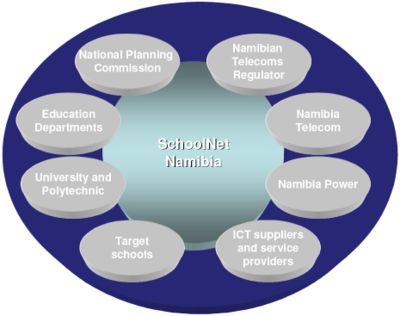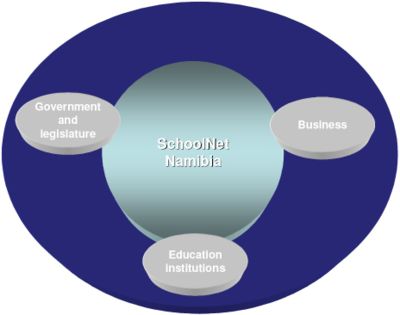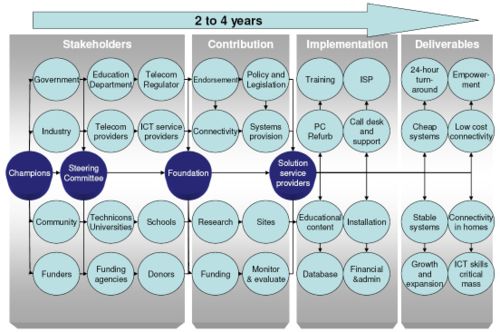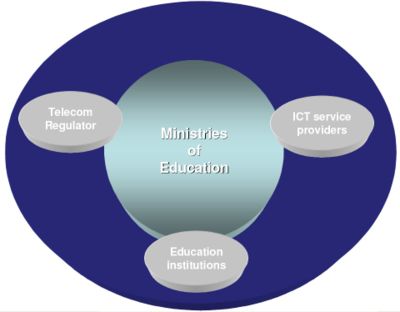Schoolnet Namibia

| Stakeholder interviews and site visits conducted by: | |
| Chris Morris | cmorris[@]csir.co.za |
| Uys du Buisson | uys[@]digimile.co.za |
| Document prepared by Uys du Buisson | |
| Date | March 2005 |
Overview
“SchoolNet (Namibia) has achieved an incredible amount. In just over five years. SchoolNet has launched an independent educational Internet Service Provider (ISP), successfully connected around 300 schools to this ISP as well as numerous other educational clients, including libraries, teacher resource centres and non-government agencies, and set up computer laboratories in these schools and in many of the other resource centres. It has also shown how these can be done in rural and disadvantaged areas where there are neither telephone lines nor connections to the power grid. SchoolNet ISP currently has some 180,000+ regular users of the internet - the nearest next commercial provider has a dial-up client base of about 11,000 users.
SchoolNet has pioneered affordable strategies and solutions for schools. Its models combine low-cost refurbished computers, free and open source operating systems, software applications and educational content, significantly discounted access to the Internet using wireless (spread-spectrum WIFI in the ISM 2.4GHz band and now in the 2.6GHz band) in remote parts of Namibia, and the offer of ICT volunteers to provide basic ICT support and training after set up and installation.
SchoolNet has become a strong voice for ICTs in schools and the education sector. Its wide contacts with key actors in the ICT and education sectors provide it with influence and leverage. Government and other actors have begun to take these issues seriously. Other similar projects are emerging.” E-mail text from Joris Komen, CEO of SchoolNet Namibia
It is abundantly clear from these powerful statements that SchoolNet Namibia has developed a model for the empowerment of students through the Internet which needs to be analysed to determine what the key success factors were. Information for the analysis was gathered during a visit to Namibia in March 2005 where the authors had the opportunity to speak to Joris Komen, SchoolNet employees and volunteers, a range of high level stakeholders and also users in rural sites in northern Namibia. The interviews were recorded and documented as the main source of information for this analysis.
'
The programme is a mature and developed Information and Communication Technology (ICT) solution for schools and has been researched from various perspectives. In keeping with the overall philosophy of the IDRC First-Mile First Inch projects in other African countries, the Outcome Mapping framework was used in this document to explore the details of the programme, to get to grips with the main aspects and to lay down a possible road map for replication in other situations.
In keeping with this framework, the Intentional Design component was applied to the SchoolNet case study to analyse the programme under the headings:
- Vision and Mission
- Boundary partners
- Outcome challenges
- Progress markers
- Strategy maps
- Organisational practices
Attention was then paid to the overall model covering the physical components of SchoolNet, the current status of the programme, a graphical representation of the components and their linkages, a broad discussion of the Open Source/Microsoft debate, before reviewing the logic of the programme.
In the analysis it became obvious that the Ministries of Education have recognised the value of the programme, have accepted its details and have started taking ownership of the mechanisms of implementation. This is an indication that a civil society initiative has been accepted into the hierarchy of educational service delivery and has become institutionalised and represents a fundamental shift in the focus of the programme. The review of the logic of the program is therefore done from the perspective of the Ministries of Education, with the identification of a new set of boundary partners, outcome challenges and progress markers.
In conclusion a second shift of emphasis is suggested regarding the acceptance at community level, the effective integration of ICT resources into learning and teaching and the institutionalisation at the user level.
Intentional design
This section explores the SchoolNet Namibia programme using the Intentional Design sub-headings of the Outcome Mapping methodology
Vision
The SchoolNet vision is gathered directly from their website and amounts to the following:
SchoolNet Namibia is driven by a vision of empowering youth through internet access and giving each student the skills to participate in the digital revolution.
Mission
To realise this vision, different mission aspects had to be dealt with. The SchoolNet approach to their mission involves:
- Gathering political support
- Establishing partnerships
- Constructing an appropriate solution
- Expanding the reach of the programme
- Regulatory endorsement
- Affordability
- Sustainability
Gathering political support
SchoolNet provided the opportunity for students to be exposed to global information, new ways of thinking and a resource base which far exceeds what the education system has been able to provide. The socio-political implications of a (private) initiative of this nature had to be considered carefully to determine whether access to the internet could be seen as a threat to the philosophy of the country and especially the ethos of its education system. High-level political support was needed to endorse the SchoolNet programme and to set the parameters within which it should operate.
Establishing partnerships
SchoolNet is a civil society idea, driven by specific champions, which needed to link with key partners to give substance to the concept. The principal partners included local communities, government officials, the private sector, academic institutions and international institutions. According to the Outcome Mapping methodology, these are the direct boundary partners which will be analysed in detail in the next section.
Constructing an appropriate solution
The vision is based on a programme of providing access to the internet and providing the skills to participate in the digital revolution for all Namibian students. To ensure user buy-in, the solution offered therefore had to be accessible, understandable, stable and affordable.
Expanding the reach of the programme
To achieve the vision of “all” Namibian students, SchoolNet had to plan to reach all the 1500 or more schools in the country.
Regulatory endorsement
Internet access can be provided through wired, wireless and satellite communications, all of which resort under the telecommunications regulatory control and the legislation relating to the use of the communications spectrum. Access to the appropriate parts of the spectrum had to be endorsed by the Namibian Telecommunications Regulator.
Affordability
The cost of connectivity is a barrier to entry in most situations. SchoolNet formulated a strategy to minimise the costs of the capital component, connectivity, training and support to make access to the internet affordable across the board in Namibia.
Sustainability
SchoolNet put strategy in place to deal with the two main sustainability issues: Finances and functions.
Boundary partners and outcome challenges
The definitions for boundary partners and outcome challenges are given and then applied:
“Boundary partners are those individuals, groups, or organisations with whom the programme interacts directly and with whom the program can anticipate opportunities for influence. The power to influence development rests with them. The programme tries to facilitate the process by providing access to new resources, ideas or opportunities (through the boundary partners).”
“An outcome challenge describes how the behaviour, relationships, activities, or actions of an individual, group, or institution will change if the programme is extremely successful”.
The identified Boundary Partners for SchoolNet Namibia are shown, together with the categories of Boundary Partners:


The boundary partners of SchoolNet Namibia and identified outcome challenges for each are listed below:
Progress markers
The outcome challenges were shown in the previous section. To make the analysis meaningful for other application situations, the progress markers for the outcome challenges are categorised according to the current status where:
| Expect to see | = Issues already dealt with and mostly in place |
| Like to see | = Issues discussed and proposed, but not necessarily in place |
| Love to see | = Future issues |
In this way, it may be possible to detail a possible road map for similar programmes to determine the situation one is in now and how the destination can be reached.
Strategy maps
This analysis deals with programme which is already in place. The Outcome Mapping framework is used to reveal aspects of the implementation and shed light on the current situation. In this section, the Outcome Challenges for two key boundary partners are given and the Progress Markers plotted on a Strategy Map to see how these fit into the various categories.
Ministries of Education
The analysis shows that the existing, intended and potential activities of the programme cover all the Causal, Persuasive and Supportive categories. This shows that sufficient attention to detail has been paid to direct activities involving individuals and groups and to the environment.
Target schools
This analysis also shows the coverage of the strategy map grid, indicating that this is a programme reaching maturity.
The same type of coverage of the strategy map grid was observed for the remaining outcome challenges.
Organisational practices
The articulation of the organisational practices of SchoolNet Namibia is based on source documentation and interviews with the people at all levels in the organisation, cross-referenced with interviews conducted with stakeholders who are not directly involved. The categories in the Outcome Mapping framework are used.
Outcome and performance monitoring
As this paper involves an examination of the SchoolNet Namibia programme to determine the lessons learnt and the potential for replication, the full evaluation framework in the Outcome Mapping is not appropriate, other than the section concerning “Reviewing the logic of the programme”. Before embarking on analysing the logic of the programme, the broad details of the model are given, the current status is analysed, the details of the implementation framework are given and the Open Source/Microsoft debate is dealt with.
SchoolNet Namibia physical and technical details
The physical and technical details of the model are given in bullet form.
Establishment of SchoolNet
- Arose from another project (insect@thon competition through museum) which sowed the seeds for introducing a broad-based PC initiative for schools.
- The strategy consisted of getting as many stakeholders to buy into the idea and to gather high level political support.
Operational components
- Central coordinating and administration structure in Windhoek.
- PC refurbishment facility.
- Call desk
- Training facility in Windhoek
- Support office in Ondangwa
Systems and configuration
- Clusters of thin client PC’s connected to server and printer.
- Configurations of multiples of 5 PC’s on a specially designed round table.
- Refurbished PC’s used (PI, II and III), combined with new machines in some instances.
- Open Source Linux 7 operating system.
Educational software
- Sourced from commercial providers in South Africa.
- Licensing and expiry date issues were observed in the field.
Connectivity
- Xnet Trust provides wireless or dial-up access technology to the schools at a reduced ‘e-rate’.
- Dial-up where copper wire is in place and wireless where it is not.
- Flat rate per month of N$300.
Support
- Support staff trained by SchoolNet.
- Toll free call desk in Windhoek. (Up to 100 calls per day).
- Local schools tend to call Ondangwa SchoolNet office.
- e-mail support requests.
- Take ownership of problem.
- Deal directly with the problem over the phone or investigate and call back with a solution.
- Teacher at the school has to say that problem is solved before call is closed.
- Calls logged on database. Some queries of the database are possible.
- Response time within one week.
- Site visits needed for some support calls.
- Preventative maintenance calls made on other schools in the area when formal support calls are done according to a planned itinerary. SchoolNet Provides vehicle.
- Use rotating teams of support staff who alternate between Windhoek and the rural stations on a 3-month basis.
Training
- Support teams trained by SchoolNet in Windhoek.
- Trainer placed at a school during the commissioning phase.
- The school has to contribute to accommodation, food and basic expenses of the trainer for a term.
Electricity
- Nam Power electrical supply where available.
- Solar power in areas not connected to the electricity grid.
Funding
- Donor funding of some aspects of the project.
- Monthly payment by schools for connectivity
Implementation process
- School submits a letter of application to SchoolNet.
- SchoolNet responds with a letter showing what it can do.
- Check to see whether the school is on the priority list or whether it matches the priority conditions.
- Letter to schools saying that they qualify and can have systems, subject to donor support (Soros and SIDA).
- Site inspection I conducted to check electricity, connectivity options and security.
- An indication of target dates is given.
- Once the go-ahead is in place the system is built and tested, then packed and shipped.
- Technicians install and do basic administration training.
- A trainer is allocated to the school for one term.
Staffing
- SchoolNet trains volunteer groups ("Kids on the Block" ) in Windhoek to be used in their operational components.
- Placement of the trainees is in support, refurbishment or schools training.
- Some trainees become employees after some time.
- Some trainees leave when they have some PC skills.
PC’s for teachers
- Refurbished PC standalone offer for teachers at N$2 500 each.
- Pay cash and have some support.
- No provision for financing the purchase.
Costs
- Systems are provided to schools for free.
- Schools pay N$300 per month for connectivity.
- Total cost of ownership for 3 years and 10 refurbished PC’s estimated at N$100 000
Current status
To start the review of the logic of the programme, SchoolNet Namibia is at a point where:
- The major groundwork has been done
- There is buy-in from the stakeholder environment
- About 25% of Namibian schools are equipped and on line.
- The education authorities endorse the initiative
- The draft ICT Policy for Education has been accepted
- The roll-out to additional schools is an ongoing activity
- Current users endorse the ICT technology and are rapidly integrating it into their daily educational routine
- Business have taken an interest and set up parallel projects as pilots for replication, in recognition of the potential business that can come from this source.
- Tertiary institutions are gearing up to deal with the increasing ICT training demand.
- The telecommunication regulatory legislation will be adapted and streamlined to enhance the potential for affordable connectivity of all schools.
It is also clear from the interviews conducted in Namibia that:
- The Ministries of Education have recognised the potential of the ICT roll-out in schools and have taken the lead in the initiative. They will be setting the guidelines and parameters in future and become actively engaged in further implementation.
- The Ministries of Education have no policy preference for any particular operating system or hardware platform and feel that users should be given the opportunity to explore all the ICT possibilities in situations where the different systems co-exist. The deciding factor for implementation has become the benefits for students and teachers, coupled with price-performance of systems used and the Ministries of Education will favour the best provider, based on these considerations.
- Although SchoolNet have done all the ground-breaking work, they are not seen as the only (or preferred) supplier and now need to compete with any other service provider who can match their offering.
- The internet access to schools product in Namibia has gone through the initial product life cycle and has evolved to a point of maturity. Increased levels of competition can be expected.
Details of the implementation network in Namibia
The network as observed in Namibia is shown graphically:

The diagram represents the clusters of activities involving:
| Stakeholders: | Champions focusing on bringing all the relevant role players into the process, forming a Steering Committee and formalising the Committee into a formal governance structure (Foundation) to define the contribution of each and to manage the linkages and implementation. |
| Contribution: | Each stakeholder contributed according to their own mandate and capability. |
| Solution service providers: | Service providers, principally SchoolNet, developed the implementation details and provided the various implementation actions. Microsoft have put parallel processes in place and can offer a competing solution. |
| Deliverables: | The main physical and philosophical deliverables are being dealt with and will be put in place in due course. |
The diagram can be used as a roadmap for replication in other situations, with the aspects ticked off a list, as they are put in place. This should be seen together with the Outcome challenges and the detailed Progress Markers. The crucial part of the process is identifying or developing champions to initiate the process and to drive it from the start to the finish.
Open Source and Microsoft
The Open Source/Microsoft debate is an issue which cropped up in many of the interviews conducted in Namibia. The main aspects of these discussions were documented, in a way that compares the two strategies and possibly reveals the areas of disagreement and synergy.
The main difference is that:
SchoolNet is a programme, with long-term strategies and objectives and sees themselves remaining in the mainstream of ICT implementation in schools, while Microsoft tested technologies and principles in Namibia, feel that they have proven a point and will pass the solution on to their resellers to continue the process.
The point of synergy and potential collaboration are:
Both have gone into the PC refurbishment business to provide affordable hardware to schools and teachers, have developed a server/thin client configuration to reduce the support requirements and each advocates a total cost model they believe is competitive.
Stakeholders interviewed outside the SchoolNet/Microsoft fold feel that taking sides would miss the point and that it was not the real issue. The focus should be on what is best for the students. The main players in the SchoolNet/Microsoft fold also stated that their different configurations could co-exist and that it would be good for users to be exposed to both options.
There can be no winner here, but just alternative options. Time will tell what the preferred solution at the user level will be.
Reviewing the logic of the programme
In reviewing the logic programme, it is useful to check the status against an alternative theoretical framework. This reveals that the civil society initiated programme has been institutionalised. This means that there should be a shift in the focus and that a different perspective may be relevant. The review of the logic of the programme concentrates on the Ministries of Education perspective and revisits the Intentional Design topics from this vantage point.
Institutionalisation
According to Latour’s Actor-Network Theory (Latour, 1996) , the establishment of any new element (such as the ICT initiative) is likely to create perplexity and resistance until it is accepted (institutionalised) as part of the network of aligned interests in the chosen implementation environment. Combined with the Due Process Model, this theory provides useful guidelines on the process that should be followed to ensure effective institutionalisation. The main steps are summarised in the table below:
It is clear that the ICT implementation for schools in Namibia has moved through these processes effectively, that adequate consultation has removed the initial perplexity, that it has found a permanent home in the hierarchy of educational activities and that the Ministries of Education have taken ownership of the programme, leading to permanent institutionalisation.
Shifting the focus
The perspective of the analysis up to this point has been the route map SchoolNet Namibia has taken to get to this point, but a new consideration is revealed:
If the programme has been institutionalised, the logic of the programme has to be reworked from the perspective of the Ministries of Education.
The Outcome Mapping Intentional Design framework will be used to do this to be able to compare and contrast with the preceding analysis.
Vision and mission
Boundary Partners, Outcome Challenges and Progress Markers
From the Ministries of Education perspective, three Boundary Partners have been identified, each of which need to be influenced to engineer changes in behaviour as analysed in the Outcome Challenges and Progress Markers.

Organisational practices
To complete the analysis of the logic of the programme, the Ministries of Education perspective is applied to organisational practices:
Next focus shift:
It ha been shown that the ICT in schools programme has been accepted into the overall hierarchy in the Ministries of Education and institutionalised. The question is;
Have the ICT resources been institutionalised in the schools?
Here we are dealing with a technology implementation at community level in which the same process (LaTour) has to be conducted, starting at the point of perplexity and moving to acceptance in the (community) hierarchy, as an outcome of extensive consultation done at community level, before institutionalisation is possible. The evidence based on site visits and interviews with teachers and students seems to suggest that the ICT initiative is seen as an add-on to the curriculum and that it is an additional (albeit interesting) activity which has not yet been integrated into learning and teaching.
The Ministries of Education as the (new) champions of ICT in schools have to deal with their ICT user base and investigate the level of institutionalisation at each of the schools to ensure the ongoing sustainability of this programme. LaTour describes the consequences of short-cutting the process and jumping directly from perplexity to institutionalisation, denying users the opportunity to accept and assimilate the development intervention. The potential exists that the users will see this as a top-down approach, resist the introduction, run interference on the implementation and refuse to accept it in their community hierarchy. The possibility exists that the ICT initiative will not be institutionalised at the local level.
The Outcome Mapping methodology can be applied at community level to determine Boundary Partners, Outcome Challenges and Progress Markers, which may reveal what is needed to realise the objectives of the Ministries of Education, teachers, students and community.